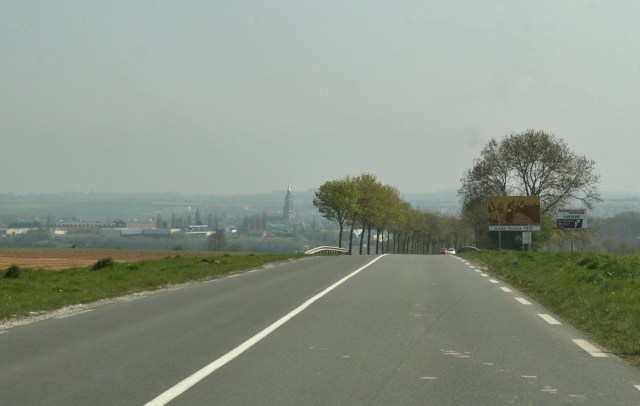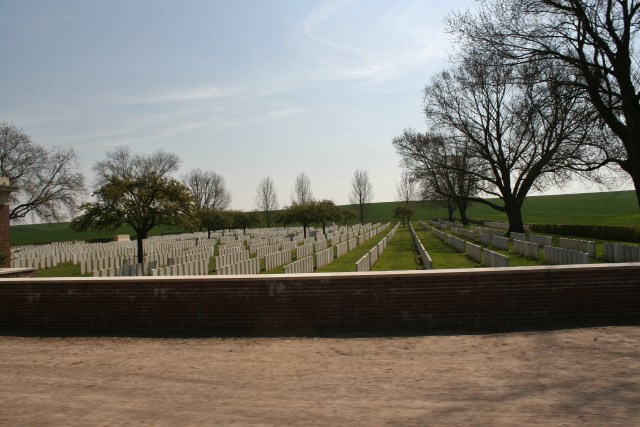A curiosity of a post, this one. A series of random photos taken over the course of a few days, stitched together to take you on a trip up the D929 from Albert to Bapaume. Exciting, eh? Well, we’ll see. We begin a little way south west of Albert, the Golden Virgin atop the Basilica glittering through the haze ahead.
There’s a ring road to the south of Albert these days…
…which rejoins the old main road half a mile north east of the city (bottom left corner of the above map). The map shows where the front lines crossed the road on 1st July (‘Front Line Befo[re 1st July]), 17th July, 13th September & 30th November, which might come in useful as we head north east.
Our route takes us past this advancing Tommy (actually a marketing piece advertising Albert’s ‘Somme 1916’ museum) and then Bapaume Post Military Cemetery (below), where we spent some time recently. If you’ve read some of the previous Somme posts you’ll recognise one or two of the photos coming up (or similar, at any rate. Identical repeats are very, very rare).
A few hundred yards past Bapaume Post Military Cemetery, obscured by the bushes to the immediate left of the road beyond the cars, this view looks back towards Albert…
…and this one ahead to La Boisselle.
As we enter the village…
…this is where the German front line crossed the road on 1st July 1916, as this sign that we’ve seen previously reminds us.
And from here we are into new territory. As the road rises through La Boisselle…
…we pass the sign to Ovillers British Cemetery…
…over on the far side of Mash Valley.
Ovillers, or Ovillers La Boisselle to give it its full title, is, as you can see, a small hamlet a few hundred yards north east of La Boisselle itself.
After the failures of 1st July 1916, early the following morning, the 6th Battalion, Queen’s Royal Regiment (West Surrey), alongside the 6th Royal West Kents, attacked to the north of Mash Valley towards Ovillers La Boisselle. This map (courtesy of the Surrey History Centre) shows the small section of the northern part of the village that the Queen’s were ordered to assault. Men who reached the German trenches found themselves cut off under a terrible artillery bombardment, as well as from machine gun fire from La Boisselle to the south and from as far away as Thiepval to the north. It would be the best part of a week before Ovillers La Boisselle was finally taken.
We leave La Boisselle…
…shortly afterwards passing this sign telling us that two kilometers ahead is the site of ‘Gibraltar’, whatever that may be,…
…until a further mile up the road, the huge brick walls surrounding the 2760 men buried in Pozières British Cemetery come into view; a further 14,000 who have no known grave are commemorated on huge panels that flank three sides of the cemetery.
It’s an imposing place, and we’ll have a proper look round at a later date…
…but today we’re not stopping, and we’re past in a few seconds.
Ahead in the fields to our left…
…this memorial remembers the men of the 1st Australian Division who fought in France & Belgium between 1916 & 1918.
On an interesting note, the small road you can see curving past the memorial was once one of the main supply routes for troops in the village; once Pozières was captured by the Australians, German artillery targeted it, thus earning it the name of ‘Dead Man’s Road’.
Just beyond ‘Dead Man’s Road’, we pass the site of Gibraltar. And Baldrick’s hooter. It was a large white blockhouse some ten foot high that the Germans used as an observation post. Oh dear, I’m sorry, I just couldn’t resist that. Ahem. We’ll try again. Gibraltar was a large white blockhouse some ten foot high used by the Germans as an observation post and as such, was heavily contested, finally being captured by the Australians just after dawn on 23rd July.
Road and CWGC signs in the centre of Pozières; place names that you read about as a kid.
We continue through Pozières…
…and as we leave (or, if you are coming from the north, as I was when I took this particular photo, as you enter) Pozières, the names of seven Victoria Cross holders, five Australians, one Brit, and one Canadian, men who received their awards for acts of valour on the Pozières battlefield in 1916, are painted on the side of this water tower.
The majority of these men received their awards for actions that took place to the south of the road, in the fields beyond the Tank Corps Memorial,…
…which stands by the side of the road a few hundred yards north of the village. Here’s a brief introduction to seven brave men:
Second Lieutenant Arthur Seaforth Blackburn (1892-1960), 10th Battalion, 3rd Australian Brigade, 1st Australian Division. Blackburn won his VC on 23rd July 1916 during the same fighting as Private Leak (below). He and his men made eight separate bombing attacks on German positions to the south of Pozières.
Private John Leak (1896-1972), 9th Battalion, 3rd Australian Brigade, 1st Australian Division. Just two hundred yards away from Blackburn, and with the Australian advance held up, Leak leapt out of a trench and destroyed the offending German strongpoint single-handed.
Private Thomas Cooke (1881-1916), 8th Battalion, 2nd Australian Brigade, 1st Australian Division. Between 24th & 25th July, Cooke, a Lewis gunner, was ordered to hold out at a highly dangerous point against German counterattacks. Which he did, until all his team had been killed around him. By the time help arrived, Cooke too was dead. His body was never recovered.
Sergeant Claude Charles Castleton (1893-1916), No 5 Company, Australian Machine Gun Corps, 5th Australian Brigade, 2nd Australian Division. On 28th July he was shot dead attempting to rescue wounded in No Man’s Land to the south of the road.
Private Martin O’Meara (1885-1935), 16th Battalion, 4th Australian Brigade, 4th Australian Division. Over several days (9th to 12th August), near Mouquet Farm to the north of the road, he brought in several officers and men from No Man’s land under intense fire, and carried ammunition and bombs through a heavy barrage to heavily bombarded trenches.
Private William Henry Short (1885-1916), 8th Yorkshires, 69th Brigade. A company bomber, he was seriously wounded in the foot on 6th August but refused treatment, remaining in a trench even after his leg was shattered, adjusting detonators and straightening pins for his comrades-in-arms. He would die of his wounds the following day.
Corporal Leo Clarke (1892-1916), 2nd Battalion, 1st Canadian Brigade, 1st Canadian Division. On 9th September, having taken a party to bomb some Germans out of a strong position, which they did, he was bayoneted below the knee by a German officer he then shot, after which he pursued more Germans, taking one prisoner, before having his wounds attended to. He would later die of his injuries at No 1 General Hospital, Étretat.
Opposite the Tank Corps Memorial we find the site of Pozières Windmill, the highest point in this part of the battlefield, as you can see. From here the Germans had a superb view of all that moved in and beyond the Britsh lines, and terrible fighting took place around here until the ruins of the mill were captured by the Australians on 4th August 1916.
Signs just up the road remind us that we are now on the site of the front lines on 1st September 1916.
A little further on this memorial remembers the men of the Canadian Corps who fought around here between 3rd September & 18th November 1916.
Away to the north the Thiepval Memorial looms above all.
Onwards towards Le Sars…
…captured on 7th October 1916.
More familiar place names.
Just north of Le Sars we pass the Butte de Warlencourt on our right (above & below)…
…and immediately after the turn off (above) to the Butte we don’t see the final pair of signs, this time denoting the front line on 20th November 1916 at the end of the battle. Just out of shot!
Soon after, we flash past Warlencourt British Cemetery…
…where more than 3500 British casualties are buried.
A post-war cemetery, begun in 1919,…
…the men now buried here were brought in from smaller cemeteries and the battlefields around Warlencourt and Le Sars.
And then the long straight road…
…until we see the spires of Bapaume.
As I said at the beginning, a curious little post, and yet hopefully not without some merit. And yes, we did stop for longer at some of the places we passed by on this short drive, as future Somme posts will reveal. Next: Pozières.















































A great post MJS – that was convenient getting a map courtesy SHC !!
I was impressed with your clean windscreen and amazed to see hoons (as we call them) leaving black tyre marks on the tarmac “As the road rises through La Boisselle…”. The media here leads us to believe hoons exist only in Western Australia (ha ha)
Was excellent to see Ausssie Diggers mentioned – thank you
Keep ’em coming mate !
Hi Sid. Thanks my friend. And for explaining about ‘hoons’. Well, sort of explaining! Plenty more Aussie stuff coming soon, I promise. And only next week I shall be returning to the Somme – my first ever ‘official’ visit, in that we have a Padre accompanying us and we shall be laying wreaths at one or two graves as we follow the East Surreys and Queens across the Somme battlefield. No Baldrick and on best behaviour* – certainly unlike our usual trips!!
*well, I’ll try!